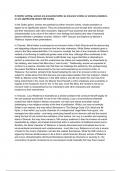Essay
A-Level English Literature OCR Presentation of Women in the Gothic - 30/30 (A*)
- Module
- Literature post-1900
- Institution
- OCR
In Gothic writing, women are presented either as innocent victims or sinister predators, or are significantly absent (30 marks). I achieved 3o/30 for this essay.
[Show more]












